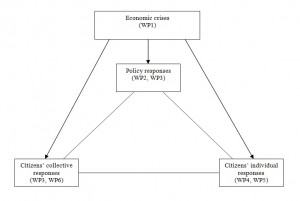Approach
 LIVEWHAT conceives resilience as the capacity of European citizens to stand against economic hardship through an active process of contestation and empowerment.
Going beyond previous studies that have studied the impact of the
economic crises on specific groups – such as children, youth, and
families – treated them as ‘passive’ categories, LIVEWHAT puts citizens engaged in alternative forms of resilience center stage.
LIVEWHAT conceives resilience as the capacity of European citizens to stand against economic hardship through an active process of contestation and empowerment.
Going beyond previous studies that have studied the impact of the
economic crises on specific groups – such as children, youth, and
families – treated them as ‘passive’ categories, LIVEWHAT puts citizens engaged in alternative forms of resilience center stage.
Alternative forms of resilience include: strengthening social and family networks and community practices so as to foster solidarity in the face of crises; changing lifestyles towards more sustainable forms of consumption and production; developing new artistic expressions, moving abroad for short or long durations. Put simply, major dissatisfaction with the economic system may enhance the strength and the resources of those who set out to engage in alternative ways of dealing with the economic crises. These transformations of citizens’ practices (from adapted to alternative), under a culture of austerity, are decisive to citizens’ future survival.
LIVEWHAT’s approach allows for studying resilience along an analytical continuum that includes, at one end, the individual level of single citizens who learn how to “bounce back” and downplay the costs of crises and, at the other end, the far-reaching forms of collective resilience, as found in the public domain, that aim to challenge inequities and foster common empowerment. In other words, individual and collective responses should not be considered as mutually exclusive strategies but rather as a range of possible ways which citizens may choose in order to respond to the economic crises and their social and political consequences.
Concurrently LIVEWHAT, while drawing on existing work on economic crises and policy responses to such crises, goes beyond the state of the art by taking into account the policy dimension of elites responses to economic crises. While these dimensions have been integrated together in a number overarching theoretical works, scholars have usually preferred to focus on either the policy domain of institutions and political elites or on the alternative domains of individuals and the civil society. Yet. moving top-down from the policy domain of institutions towards the citizenry means that we need to broaden our theoretical perspective so as to take into account the bottom-up interventions by ordinary citizens.
The figure below illustrates the triangle of responses to economic crises, which forms LIVEWHAT’s conceptual framework. It also presents which workpackages of the project deal with which type of responses. Specifically, Workpackage 1 addresses the exogenous variable represented by the economic crises; Workpackage 2 and Workpackage 3 deal with policy responses (by means of policy measures and thought discursive interventions in the public domain); WP3 and Workpackage 6 examine citizens’ collective responses (in the public domain and through alternative forms of resilience); and Workpackage 4 and Workpackage 5 investigate citizens’ individual responses (in both descriptive and explanatory ways).
Figure: Conceptual framework of the research and relation to workpackages

